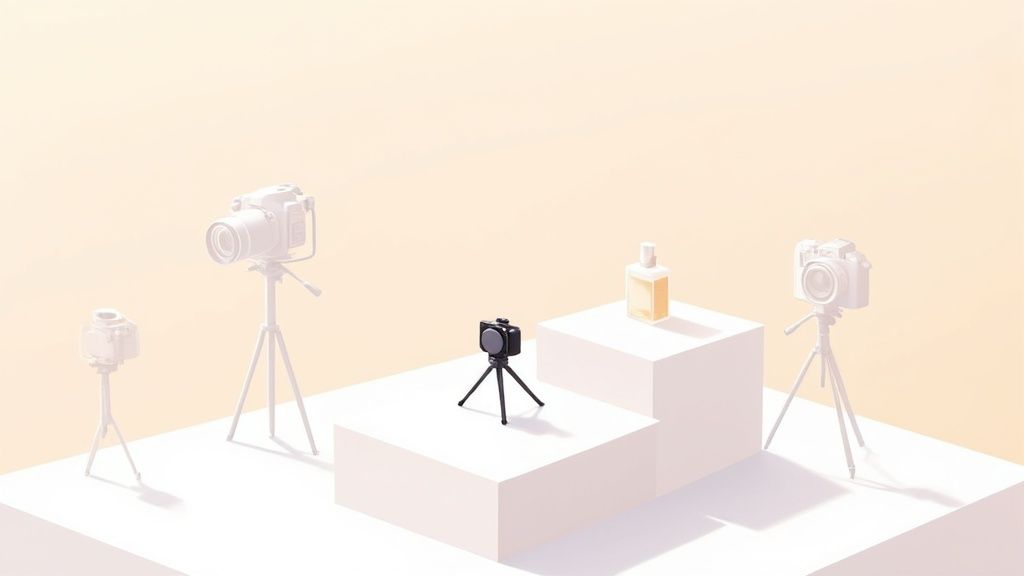Figuring out the best camera for product pictures really comes down to what you need for your business. But if I had to give a straight answer, modern mirrorless cameras have become the sweet spot for most sellers, hitting that perfect balance of image quality, user-friendliness, and features that won't feel dated in a year. The trick is finding the right one that fits your budget, the kind of products you sell, and how comfortable you are behind a lens.
Choosing the Right Camera for Your Business
Think of your product photos as your digital handshake. They're often the very first, and sometimes only, interaction a potential customer has with your item. Getting the right camera isn't just about buying a piece of hardware; it’s a direct investment in your brand's reputation and your power to turn a casual browser into a committed buyer. This one decision affects everything—from showing off the fine stitching on a leather bag to getting the color of a lipstick just right. It's what gives a customer the confidence to click "add to cart."
So, where do you start? First, get a clear picture of your specific needs. Are you shooting tiny, detailed jewelry or massive pieces of furniture? Will you have a dedicated studio space with controlled lighting, or are you making do with natural light by a window? Your answers will point you toward the right system, whether it’s a do-it-all mirrorless camera, a workhorse DSLR, or even a high-end compact.
Aligning Your Camera with Your Business Goals
The camera you pick should fit seamlessly into how you work and where you want your business to go. Here are a few things to chew on:
- Budget vs. Quality: Figure out what you can spend, but think beyond just the camera body. You'll need to account for lenses and lighting, too. A good way to frame your budget is to look into the cost of professional product photography. Seeing what the pros charge can give you a solid benchmark for investing in your own gear.
- Ease of Use: If you're just starting out, a camera with a simple menu and helpful on-screen guides can make a world of difference. It'll flatten the learning curve and get you shooting faster.
- Scalability: Don't box yourself in. Choose a camera system that has a wide range of lenses and accessories available. That way, as your business grows and your creative ambitions expand, your gear can grow right along with you.
The right camera isn't just a tool for taking pictures; it's a strategic asset that enhances your product's appeal, builds customer trust, and directly contributes to sales growth.
Make no mistake, the demand for killer visuals is exploding. The global eCommerce product photography market was valued at USD 0.85 billion in 2025 and is on track to hit USD 2.38 billion by 2034. That's not just a trend; it's a fundamental shift in online retail. This growth highlights just how crucial it is to have equipment that can churn out professional-grade images, shot after shot. To make sure your photos are really working for you, it's also worth applying visual merchandising guidelines to your entire setup.
When you're picking out a camera for product photos, it's easy to get lost in brand names. But what really matters are the specs that directly shape your final image. Getting a handle on these features is the difference between buying just any camera and buying the right camera for your business.
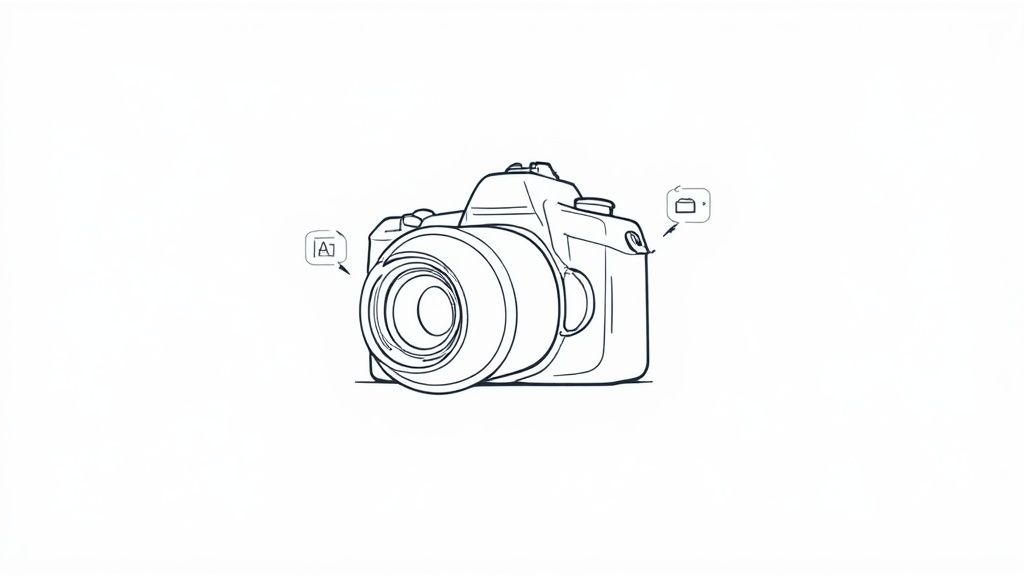
This knowledge gives you the power to look at any model and know if it can deliver the clean, professional shots your store needs. Let’s break down what you should actually be looking for.
Sensor Size: The Foundation of Image Quality
Think of the camera's sensor as the canvas for your photo. Its size dictates how much light and detail it can soak up. The two main types you'll run into are full-frame and APS-C.
A full-frame sensor is the larger of the two, and its size advantage lets it capture more light. This translates to cleaner images with less digital "noise," especially when you don't have perfect lighting. It also makes it easier to get that beautiful, blurry background (shallow depth of field) that makes your product pop.
An APS-C sensor is smaller and is the standard for most budget-friendly and mid-range cameras. Don't let the size fool you; modern APS-C sensors are incredibly capable and deliver fantastic results for e-commerce. Their main trade-offs are a bit more noise at higher ISO settings and a "crop factor," which essentially makes your lenses feel more "zoomed in."
Megapixels and Cropping Flexibility
Megapixels (MP) are all about resolution—the amount of detail in your image. For product photography, more is often better. A higher megapixel count captures the tiny details, like the texture of a fabric or the fine lines in a piece of jewelry.
A camera with at least 24MP is a great starting point. That gives you plenty of detail for online stores and, just as importantly, the freedom to crop your photos in post-production without them looking soft or pixelated. This is a huge deal when you need to create different compositions for social media or zoom in on a specific feature for a marketing banner.
Your goal is to capture images so sharp that customers can zoom in and inspect every detail with confidence. A higher megapixel count is your safety net, ensuring quality is never compromised, even after an aggressive crop.
Manual Control and Studio Workflow
Beyond the core specs, a few features are absolutely essential for a smooth studio workflow.
- Full Manual Mode: This is a must-have, no exceptions. Manual mode gives you direct control over aperture, shutter speed, and ISO. This is the only way to guarantee perfectly consistent lighting and exposure from one shot to the next.
- Tethering Capability: This is a game-changer. Tethering lets you connect your camera to a computer so your photos appear on a large screen the instant you take them. You can check focus, lighting, and composition in real-time without squinting at the tiny screen on the back of the camera.
- Advanced Autofocus: While a lot of product photography happens with manual focus, a fast and reliable autofocus system is invaluable. If you're shooting products on a model or creating more dynamic lifestyle shots, a good AF system with subject tracking ensures your key features stay perfectly sharp, every single time.
Comparing the Best Cameras for Product Pictures
Picking the right camera for product pictures isn't about finding the "best" one, but the best one for you. Instead of just rattling off a list of popular models, we're going to look at this from a real-world business perspective. Are you a solopreneur just starting out, or a high-volume studio that needs a powerhouse?
We’ll break down a few top contenders based on who they’re for, focusing on how their specific features solve actual product photography problems. This way, you'll find a camera that not only captures beautiful images but also slots perfectly into your budget and workflow.
The Small Business Workhorse
If you're a small business owner—maybe running an Etsy shop or a Shopify store—you live and die by efficiency. You need a camera that’s dependable, easy to master, and produces consistently sharp, color-accurate shots without a massive learning curve. The Sony a6400 is a legend in this space.
Its secret weapon is Sony's incredible Real-time Eye AF and Tracking. While it was first built for portraits, this feature is a game-changer for product shots. It locks onto your subject with lightning speed, ensuring every little detail is tack-sharp, which is perfect whether you're shooting with a model or just trying to nail the focus on a tiny piece of jewelry. Paired with a 24.2MP APS-C sensor, you get more than enough resolution for stunning web images and plenty of room to crop.
It's also compact and light, making it a breeze to set up and move around, even if your "studio" is just a corner of your living room. The a6400 is a practical, powerful tool that gets you pro-level results, fast.
The Professional Studio Powerhouse
For professional studios and established e-commerce brands, there's no room for compromise. When clients demand perfection, you need a camera like the Canon EOS R5. Its beastly 45-megapixel full-frame sensor captures an insane amount of detail. This is exactly what you need for huge prints, intricate close-ups, and luxury products where every single texture needs to pop.
The real magic of the Canon EOS R5 is its color science. It produces rich, true-to-life colors straight out of the camera, which drastically cuts down on editing time. More importantly, it ensures your product colors are accurately represented online—a huge factor in reducing returns from customers claiming "it didn't look like the picture."
Plus, its tough build and advanced tethering capabilities make it feel right at home in a busy studio environment. It’s a serious investment, but the EOS R5 delivers the world-class resolution and color fidelity that high-end clients expect.
To give you a clearer picture of how different models stack up, this chart compares some key specs for popular APS-C cameras.
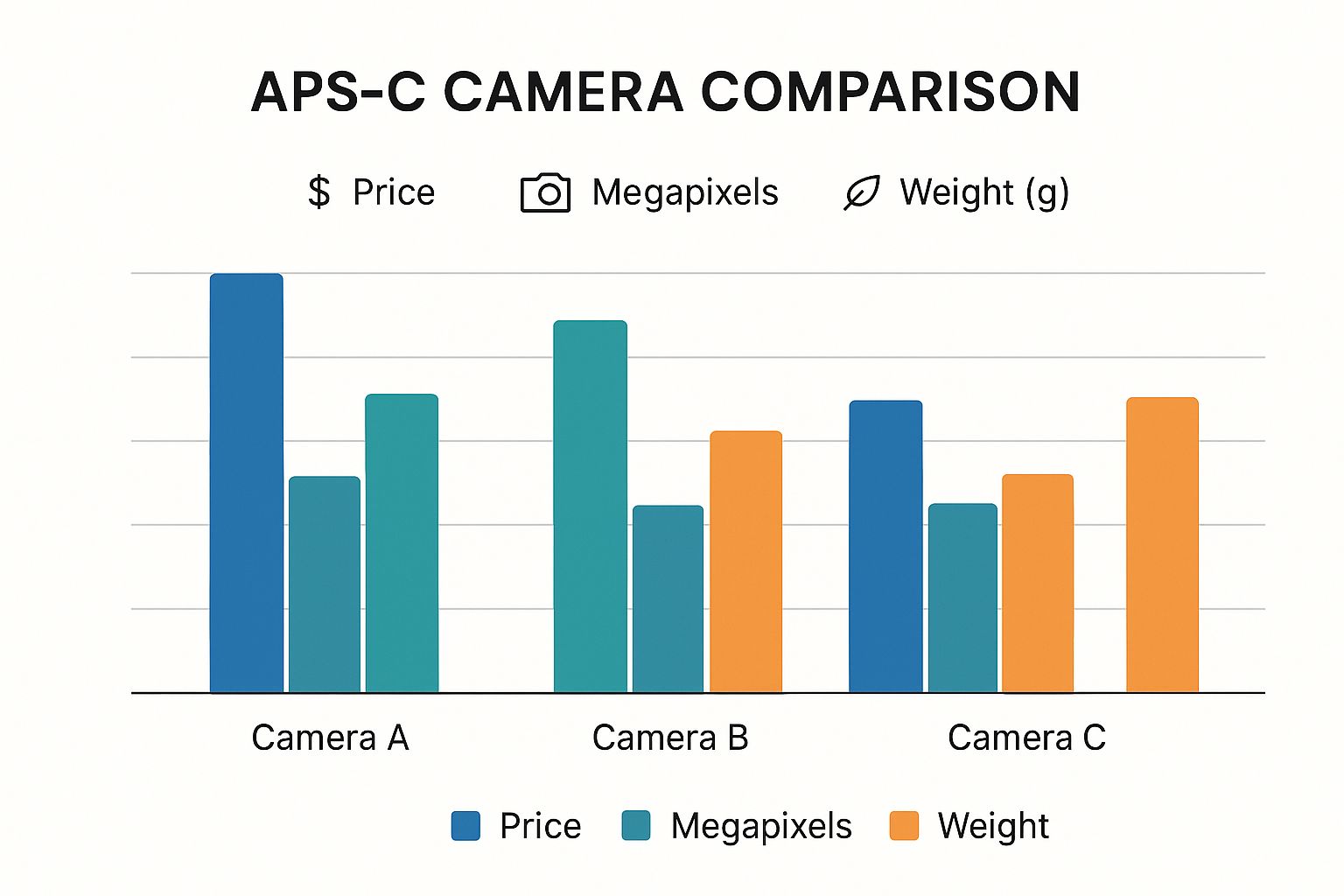
You can see the trade-offs at a glance, helping you decide whether to prioritize a lighter body, higher resolution, or a lower price point.
The High-Value Budget Option
Just getting started or watching your budget? The Canon EOS Rebel T7 is a fantastic entry point into the world of high-quality photography. It’s a DSLR, which means it gives you the fundamental manual controls you need to truly learn the craft—a skill that will pay dividends for years to come.
The Rebel T7’s 18-megapixel APS-C sensor is more than enough to create sharp, clean images for Amazon, eBay, or any other online marketplace. Its menu system is straightforward and won't overwhelm a beginner. Best of all, it opens the door to Canon's massive ecosystem of affordable lenses, letting you upgrade your glass as your skills and business grow. You can learn more about what different platforms require in our guide to professional Amazon product photography.
It also helps to look at the bigger picture. In 2023, Canon sold 3.35 million of the 7.2 million digital cameras shipped worldwide, grabbing a massive 46.5% market share. Sony and Nikon followed with 26.1% and 11.7%. This market dominance means you're investing in a brand with a proven track record and long-term access to lenses, accessories, and support.
Top Camera Models for Product Pictures: A Feature Comparison
To help you see how these options compare side-by-side, here's a table breaking down the key features that matter most for product photography.
| Camera Model | Sensor Size | Megapixels | Key Feature for Product Shots | Ideal User Profile | Approx. Price (Body) |
|---|---|---|---|---|---|
| Sony a6400 | APS-C | 24.2 MP | Real-time Eye AF & Tracking | Small business, Etsy/Shopify seller | $900 |
| Canon EOS R5 | Full-Frame | 45 MP | Superior color science, high resolution | Professional studio, high-end brands | $3,400 |
| Canon EOS Rebel T7 | APS-C | 18 MP | Manual controls, lens compatibility | Beginner, tight budget | $400 |
This comparison highlights the trade-offs between price, performance, and features, making it easier to pinpoint the camera that truly aligns with your specific business needs and goals.
Why Mirrorless Cameras Excel in Product Photography
The move away from big, clunky DSLRs to sleeker mirrorless systems isn't just a passing trend; it's a real shift in how professional photos are captured. For anyone shooting products, this change brings some huge advantages that lead to a faster workflow and, frankly, better pictures. It's why they’ve become the go-to camera for product shots today.
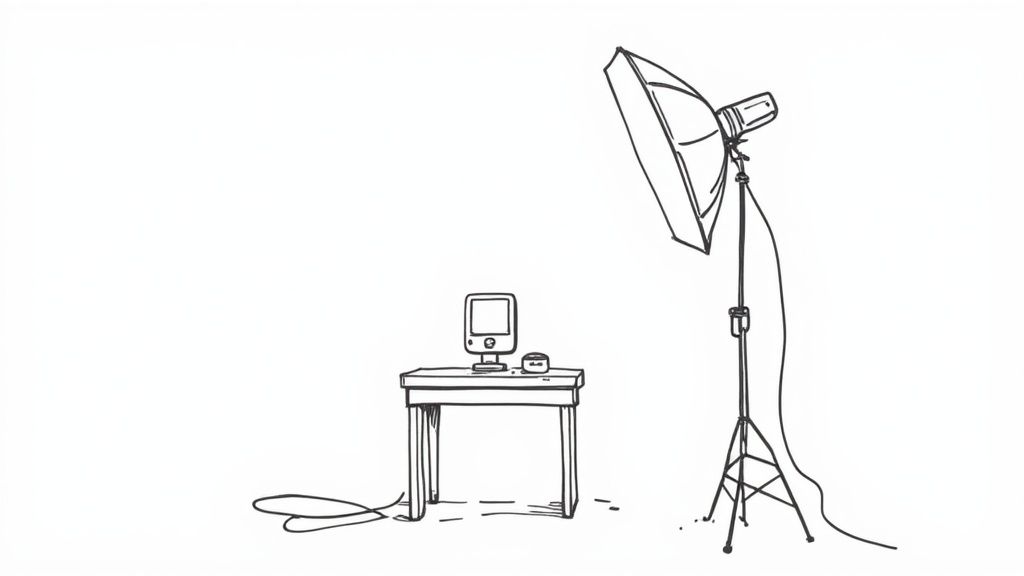
Unlike a DSLR, which uses a mirror to show you the scene through an optical viewfinder, a mirrorless camera’s Electronic Viewfinder (EVF) is basically a tiny, high-quality screen. This means you’re seeing a live preview of what your final photo will look like, including any changes you make to exposure, white balance, or color settings.
This what-you-see-is-what-you-get approach is a total game-changer in a controlled studio environment. You can nail your settings perfectly before you even take the shot, which cuts down on endless test photos and speeds up your entire process.
Superior Autofocus and Silent Operation
Mirrorless cameras are also miles ahead when it comes to autofocus. They use on-sensor phase-detection pixels that cover almost the entire frame, giving them a level of speed and precision that older DSLR systems just can't touch.
For product photography, this lets you:
- Get razor-sharp focus on the tiniest details of your product with pinpoint accuracy.
- Reliably track subjects, which is great if you’re shooting products on a model or creating more dynamic lifestyle images.
- Focus faster and quieter, making for a much smoother and more professional workflow.
On top of that, many mirrorless models have a completely silent electronic shutter. In a quiet studio, the loud clack of a DSLR's mirror can be pretty distracting. A silent shutter gets rid of that noise, creating a calmer, more focused environment for everyone.
The real magic of mirrorless tech is how direct it is. By getting rid of the mirror, the camera gives you a real-time digital preview, letting you make creative choices instantly instead of after you've already taken the picture.
The Clear Industry Shift
You just have to look at the numbers to see where things are headed. In 2025, mirrorless and compact camera sales are bouncing back in a big way, all thanks to their better tech and smaller size. Meanwhile, DSLR shipments have cratered, falling to 78.5% of last year's levels as pros and hobbyists alike jump on the mirrorless train. If you're curious, you can explore the latest camera sales data to see this shift for yourself.
Let’s be honest, older DSLR technology is becoming obsolete for the kind of precision modern e-commerce demands. Their bulky mirror box and clunkier autofocus systems just don't cut it anymore. Their optical viewfinders can't show you a live preview of your exposure, and their focus systems are often less accurate, especially in live view. For anyone buying a new system today, a mirrorless camera is simply the smarter, more future-proof choice for capturing incredible product images.
Building Your Complete Product Photography Kit
Picking the right camera is a huge first step, but the camera body itself won't deliver those jaw-dropping product shots. Think of it as the brain of your operation; it still needs eyes (lenses) and the right environment (lighting) to truly create magic. A complete, well-thought-out kit is what separates simple snapshots from images that actually sell your products.
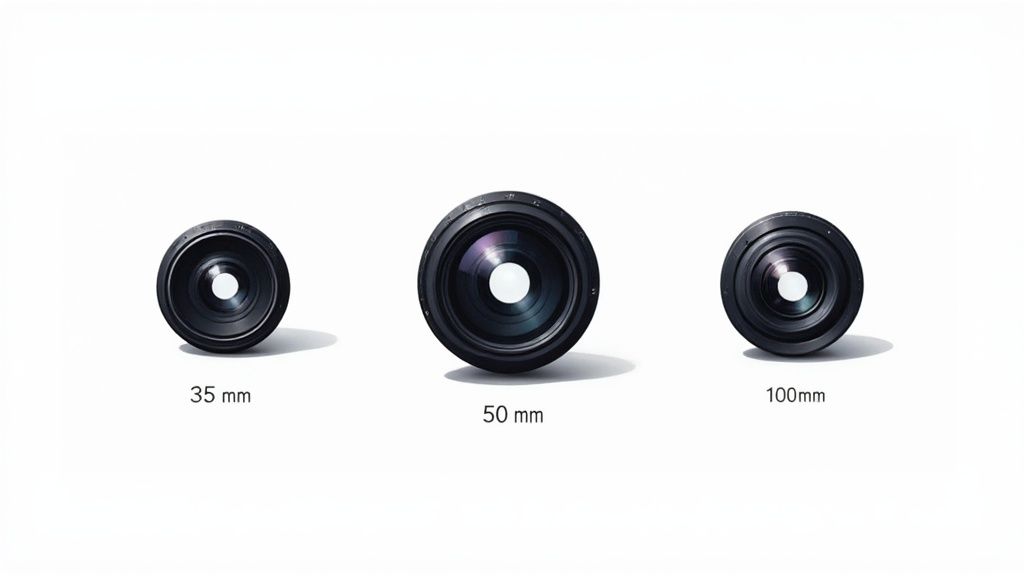
Most people start out with the "kit lens" that comes bundled with their camera. They get the job done, sure, but these are general-purpose zooms. They just don't have the optical chops for the crisp, high-detail photos you need. Honestly, upgrading your lens is one of the single biggest improvements you can make to your image quality.
Essential Lenses for Product Shots
For studio work, nothing beats a prime lens—one with a fixed focal length. They are built for one thing: sharpness.
- A 50mm Prime Lens: This is the legendary "nifty fifty." It’s affordable, tack-sharp, and incredibly versatile. The focal length is very close to what the human eye sees, so your products look natural and true-to-life.
- A 100mm Macro Lens: If you sell anything with fine details—jewelry, watches, electronics—this is your secret weapon. A macro lens lets you get ridiculously close, revealing textures and craftsmanship that other lenses simply can't capture.
Investing in a quality prime or macro lens will give you a much more noticeable jump in image quality than upgrading your camera body. At the end of the day, it's the lens that resolves the fine details that make a product look premium.
Mastering Your Lighting Setup
Good lighting isn’t optional; it’s everything. It carves out the shape, reveals texture, and sets the mood for your product. You can get by with natural window light, but for consistency and that professional polish, you need a controlled lighting setup. The classic three-point lighting arrangement is the perfect place to start.
This setup uses three distinct light sources to sculpt your product:
- Key Light: This is your main, brightest light. You'll place it off to one side to create highlights and define the product's form.
- Fill Light: A softer, less powerful light goes on the opposite side. Its job is to fill in the harsh shadows created by the key light.
- Back Light: Placed behind the product, this light creates a subtle outline that separates it from the background, adding a ton of depth.
For an affordable and effective setup, grab a pair of LED panels and some softboxes. Softboxes are just fabric diffusers that go over your lights, creating a soft, even glow that makes almost any product look fantastic.
Once you’ve nailed the shot, professional product photo editing services can add that final layer of polish, making sure your background is pure white and the colors pop.
Of course, gear is only half the battle. Knowing how to take photos for an eCommerce store listing is what turns your investment into actual sales. With the right camera, lenses, and lighting, you’ve got all the tools you need to make your products look absolutely irresistible.
Picking the right camera for your product photos isn't about chasing the highest specs or the fanciest model. It’s about finding the right tool for your specific job. To cut through all the tech-speak and endless reviews, just start by asking yourself three simple questions. Your answers will point you straight to the camera that actually makes sense for your business.
Key Questions to Ask Yourself
Before you even think about megapixels or sensor sizes, get real about the practicalities of your setup. Your answers here will narrow down the options faster than anything else.
- What's my real budget for the entire kit? Don't just think about the camera body. You need to factor in lenses and, most importantly, lighting. A great camera with bad lighting is a waste of money.
- What am I actually shooting? Tiny, detailed jewelry has completely different needs than large pieces of furniture. The size and type of your products will dictate the kind of lens and setup you need.
- How much time can I realistically spend learning this stuff? Some cameras are incredibly intuitive and almost work on autopilot. Others offer a universe of manual controls but come with a much steeper learning curve. Be honest with yourself.
The right camera isn't just a gadget that takes pretty pictures; it’s a business tool. The goal is to find one that aligns with your budget, products, and skill level to deliver a clear return on your investment by driving more sales.
Once you have those answers, you can confidently pick a camera that not only captures incredible images but also fits right into your workflow without causing headaches. This approach ensures you're investing in a tool that truly helps your products look their absolute best online.
Of course, here is the rewritten section, crafted to sound like an experienced human expert and match the provided examples.
Final Questions About Product Photography
Even after picking a camera, a few common questions always seem to pop up. Let's tackle some of the things we hear most often from sellers who are just getting started.
Can I Get By With Just My Smartphone?
When you're just starting out, absolutely. The cameras in modern smartphones are surprisingly powerful and can deliver great results for your first product listings, especially if you nail the lighting.
But they do have a ceiling. A real camera gives you crucial control over settings like aperture, which lets you create that blurry background effect (known as depth of field). You also get much higher resolution for cropping and the ability to use specialized lenses, like a macro lens for capturing tiny details. As your shop grows, you'll find that upgrading is the key to creating a consistently professional look.
Is 4K Video a Must-Have for Product Photos?
Nope. For still images, 4K video is irrelevant. While many new cameras come packed with impressive video features, your focus should be squarely on the photography specs: sensor size, megapixel count, and manual controls.
Video is a totally different ballgame. If you're planning to shoot product demos or ads down the line, then having 4K is a nice bonus. But it won’t make your static product shots any better.
What Are the Best Camera Settings for Product Shots?
Every product and lighting setup is a little different, but there’s a solid starting point for studio work that rarely fails.
For a controlled studio setup, a great baseline is an aperture of f/8 to f/11, an ISO of 100, and then adjusting your shutter speed until the exposure is perfect. This combo gives you maximum sharpness with virtually no digital noise.
And remember, using a tripod is non-negotiable here. It’s the only way to guarantee your images are tack-sharp and free of any camera shake.
Ready to create stunning, professional product images in seconds without the expensive gear? ProdShot uses AI to transform your simple photos into high-converting, marketplace-ready visuals. Try it free and see the difference at https://prodshot.net.

